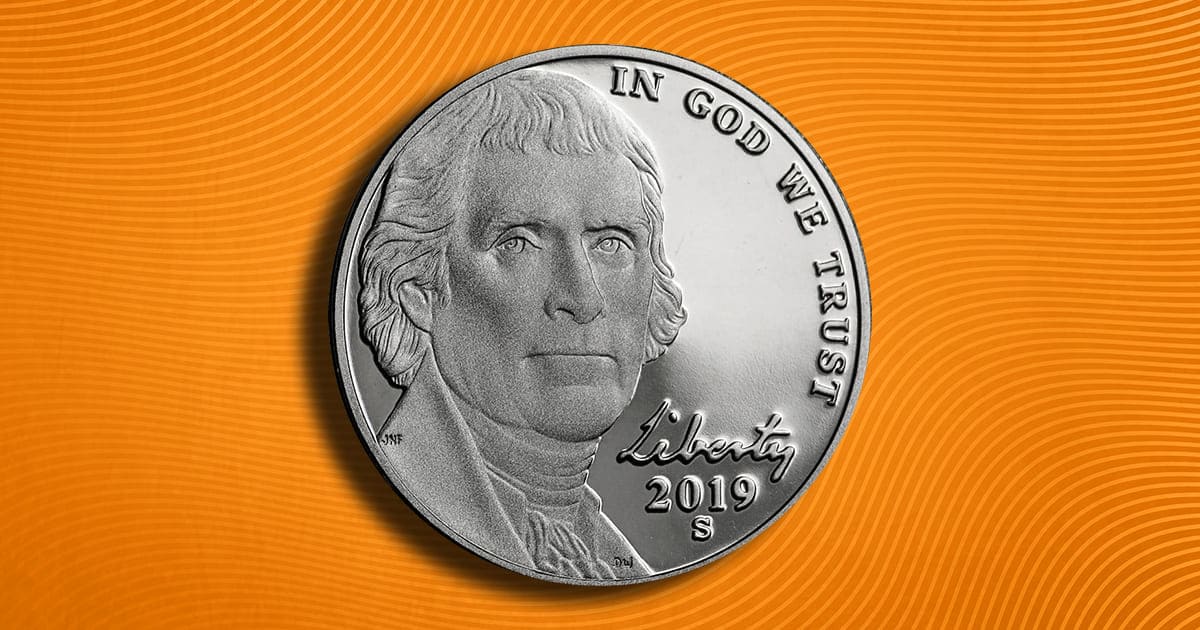
The Jefferson Nickel Replaced the Buffalo Nickel
The Jefferson Nickel has been in circulation since 1938, when the Buffalo or Indian Head Nickel was discontinued. It has undergone numerous changes in its 84-year history, including compositional and design changes.
The 1938 Jefferson Nickel (1938-1942)
Felix Schlag designed the 1938 iteration. He competed against 390 other artists for a $1,000 Prize. This is the ‘classic’ Jefferson Nickel, featuring the profile of Thomas Jefferson on the obverse and Jefferson’s home, Monticello, on the reverse.
Schlag’s design won in the court of public approval for using portraiture and pictorial thematic coin designs over the symbolic design of America’s older coinage.
Wartime Silver Alloy Jefferson Nickels (1942-1946)
From 1938-1942, the Jefferson Nickel was composed of .750 Copper and .250 Nickel. But when Nickel was identified as a strategic metal during World War II, the Jefferson Nickel changed composition.
The Wartime Jefferson Nickel was minted using a Silver alloy composed of .560 Copper .350 Silver, and .09 Manganese. This freed Nickel supplies so the United States could produce armor, weapons, and other military equipment, including plating for aircraft, tanks, and naval vessels. While the materials that went into the Jefferson Nickel changed, the coin’s weight and dimensions remained unchanged.
A Return to Pre-War Jefferson Nickels (1946-2003)
In 1946, after the end of World War II, Jefferson Nickels were again made from .750 Copper and .250 Nickel. The Jefferson Nickel did not undergo any further changes for another 20 years.
Felix Schlag’s initials were added below President Jefferson’s bust in 1966, with Mint dies remodeled to strengthen the design in 1971, 1972, 1977, and again in 1982.
The Jefferson Nickel’s mintmark position moved from the reverse to the obverse in 1968. That year, Philadelphia Mint workers manually hand-punched the mintmark into the dies, which resulted in variations of the mintmark location.
Westward Journey Jefferson Nickels (2004-2005)
The Westward Journey Nickel Series were minted in 2004 and 2005. They celebrated the bicentennial of the Louisiana Purchase and the Lewis and Clark exhibition, and each year’s issue had two different reverse designs.
The 2004 issue of the Westward Journey Nickel Series featured designs adapted from historical medals.
The Keelboat reverse was designed by Mint sculptor Al Maletsky and depicts the 55-foot boat that Lewis and Clark’s party used. This boat was built to the specifications of Captain Lewis, so it could be rowed, sailed, poled like a raft, and towed from a riverbank.
The Peace Medal reverse was designed by Mint sculptor Norman E. Nemeth and features symbols of friendship and peace.
In 2005, a new portrait of President Jefferson was used for the Westward Journey Nickel Series. This obverse portrait took inspiration from a 1789 marble bust by Jean-Antoine Houdon and was designed by Joe Fitzgerald. It used Jefferson’s handwriting to inscribe the word “Liberty.”
The American Bison 2005 Nickel reverse was designed by Jamie Frankie and depicts an American Buffalo in profile. Bison held great significance for many of the Native American tribes.
Joe Fitzgerald also designed the “Ocean in View” obverse of the 2005 strike, which features cliffs hanging over the Pacific Ocean. This reverse was inspired by Clark’s journal entry on November 7, 1805, upon seeing the Pacific on their westward journey. “Ocean in view! O! The Joy!”
Modified Jefferson Nickels (2006- To Date)
After the Westward Journey series, the Monticello reverse returned to the Jefferson Nickel, but the obverse changed again. The 2006- to date Jefferson Nickels depict a facing portrait of Thomas Jefferson designed by Jamie Franki.
Interested in collecting Jefferson Nickels? For beginners, the 1964-D Nickels are a popular and affordable place to start your journey.




